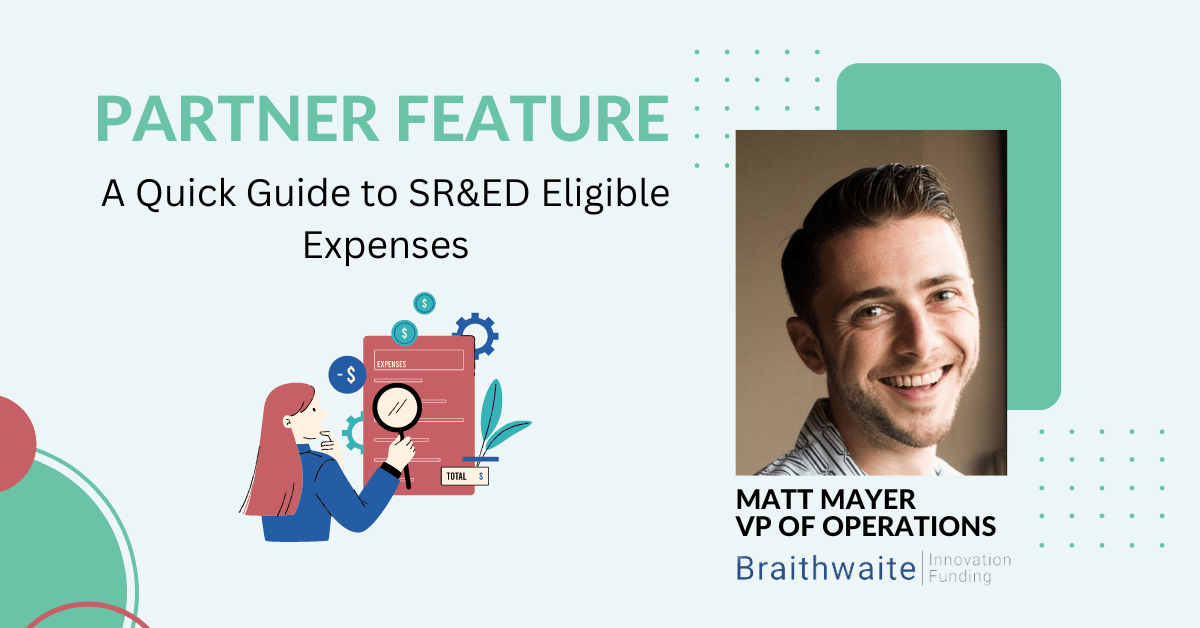The Scientific Research and Experimental Development (SR&ED) program serves as the government’s largest source of financial incentives specifically designed to support business-led research and development projects. Knowing what to be aware of when filing and, by extension, having a rough idea of how to calculate your refund is essential to optimizing your capital stack and building for the future.
Below, we’ll explore key factors to keep in mind when calculating your SR&ED refund.
Eligible Expenditures
In order to maximize your SR&ED tax credit, it’s crucial to accurately document and claim eligible expenses under the scope of the program. In alignment with the overall intent and purpose of the SR&ED program, eligible expenditures refer to costs directly associated with eligible R&D activities, including:
Wages and Salaries:
In order to pursue new developments and investigative experimentation/research, it’s feasible to assume you’ll need to hire and maintain salaries for dedicated professionals who handle specific components of your project. Eligible salaries include those that are directly tied to the eligible projects you’re claiming, such as scientists, engineers, statisticians, and even human resources.
Subcontractor costs may also be eligible, but it must be a Canadian based subcontractor, and activities must still meet the criteria for SR&ED.
Note: the entire salary of SR&ED-related employees may not always be eligible to be claimed. The time they spent directly working on SR&ED eligible projects divided by their total salaried work hours for the year will give you the portion of their salary that can be claimed.
Materials:
Costs for materials, substances, or equipment used in R&D are also eligible. This can encompass everything from laboratory supplies to software and hardware. Materials must be consumed or otherwise rendered un-usable in order to qualify for SR&ED credits.
Overhead Expenses:
Overhead expenses directly related to your SR&ED activities, such as utilities or rent for facilities used for R&D, can also be claimed within the scope of the program.
To ensure your expenses are refunded to the maximum amount, you should maintain highly detailed and accurate documentation and record-keeping notes. Such records are essential for assisting with your claim and are invaluable in the case of a CRA audit.
Overhead costs can be claimed either by using the proxy method, which adds a 55% top-up to claimed salaries to account for overhead, or the traditional method, which involves a more complex process.
Identifying Eligible SR&ED Activities
To claim SR&ED tax credits, you must be able to identify and showcase the specific activities within your business that qualify for the program. Eligible SR&ED activities typically involve scientific or technological advancements and must meet specific criteria, such as:
Technological Uncertainty: Your work must address technological uncertainties, meaning that there is uncertainty about the outcome of the project. In other words, your project must strive to find a resolution for unknown variables that cannot be resolved using current technology or understanding.
Systematic Investigation or Experimentation: Your SR&ED activities must involve a provable systematic approach to experimentation, including planning, testing, and data collection.
Advancement of Knowledge: As with technological uncertainty, your work should result in the advancement of scientific or technological knowledge, not just routine development or commercial activities.
Record Keeping
It is imperative to note that robust record-keeping and extensive documentation are essential for a successful SR&ED claim. You must keep thorough records of all stages of your project, experimentation results, project description, and technological challenges you’ve encountered (and how you’ve overcome them where possible). You’ll also want to clearly detail your experimentation process thoroughly, including hypotheses, methods, results, and conclusions.
In addition to project-specific details, it’s vital to keep organized financial records that link your expenditures to specific, eligible SR&ED activities. Invoices, payroll documents, and other financial documents should be readily accessible and can help significantly should you face a CRA review.
Financing Your SR&ED Credits
Finding the right SR&ED financing provider is essential to extending your runway and covering gaps that may leave you stranded otherwise. At Venbridge, we’re proud to offer founder-friendly, non-dilutive capital that empowers you to pursue innovation with minimal stress.
Learn how partnering with Venbridge can enhance your R&D initiatives and assist your business through SR&ED financing by contacting our team today!




